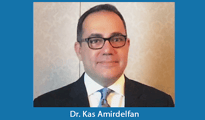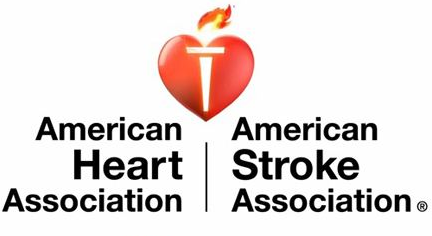Kas Amirdelfan, MD talked with SmartTRAK at the ASRA 2017 Annual Meeting regarding preliminary 12 month results from the SENZA-ULN study
 Kas Amirdelfan, MD, principle investigator of the SENZA-Upper Limb and Neck (ULN) study, spoke with SmartTRAK's Anne Staylor at the recent American Society of Regional Anesthesia and Pain Medicine (ASRA) annual meeting in Lake Buena Vista, FL regarding preliminary 12 month results from SENZA-ULN, the unmet clinical need for chronic intractable ULN pain, factors affecting physician adoption for this indication and what’s next for this research. (See ASRA Poster 4194.)
Kas Amirdelfan, MD, principle investigator of the SENZA-Upper Limb and Neck (ULN) study, spoke with SmartTRAK's Anne Staylor at the recent American Society of Regional Anesthesia and Pain Medicine (ASRA) annual meeting in Lake Buena Vista, FL regarding preliminary 12 month results from SENZA-ULN, the unmet clinical need for chronic intractable ULN pain, factors affecting physician adoption for this indication and what’s next for this research. (See ASRA Poster 4194.)
A transcript of SmartTRAK’s interview with Dr. Amirdelfan is below or click on the following video to view the interview recorded live at ASRA 2017. (13:23 minutes.)
SmartTRAK: Today you have a poster you'll be presenting with preliminary twelve month results of the SENZA upper limb and neck study. Could you just give us a summary of the study and highlight some of the key findings?
Kas Amirdelfan, MD: Absolutely. This is one of the highlights of my career. We started this study about a year and a half ago. The study is designed to treat patients with upper limb and axial neck pain with spinal cord stimulation that has HF10 Therapy or 10,000 hertz frequency. This technology has been around for a few years now. We've seen the kind of optimal outcomes we've gotten from it in the low back and leg pain studies that have been done before this, such as the SENZA-RCT or the SENZA European study done with Dr. Al-Kaisy and Dr. Van Buyten. That became the foundation for us to do this study. It's a single arm, multi-center study with patients with upper limb and/or neck pain.
We engaged the appropriate patients for the study. We enrolled them. We did a trial on the patients. The patients who were successful were finally implanted with a permanent device. We've been following them over the past few months. About half of the patients have gotten to the 12-month mark at this point. The last patient in this study will get to the 12-month mark, which is the end point of the study, in February of 2018.
The results in my abstract today is the preliminary results of the 12-month cohort of the study. What we've been able to show is nothing short of spectacular. We've not only been able to reduce the patient's upper limb pain by a significant amount, but we've also been able to control axial neck pain for the first time in the history of spinal cord stimulation on a long-term basis.
“What we’ve been able to show is nothing short of spectacular…we’ve been able to control axial neck pain for the first time in the history of spinal cord stimulation on a long-term basis.”
In the past, with traditional spinal cord stimulators, since they were paresthesia based, and there's a lot of tingling that's associated with them, the patients really didn't like having them implanted in their cervical spine. They would get terrible positional effects as they would move their neck back and forth. They would eventually abandon their devices. With the paresthesia free device, we can certainly do that and treat the patients better, but even in our hands, we didn't know whether we were going to be able to get axial neck pain controlled the way we have. But the results have just been impressing all the investigators and some of the people who've seen the preliminary results so far.
You have how many patients who are enrolled in this study?
KA: A total of 47 patients have been enrolled in the study. Well, no. That's not true. More patients were enrolled in the study, but 47 patients have been implanted in the study.
Okay, and then what kind of responder rates were you seeing between three and twelve months? Is that improving or ...
KA: The responder rates are over 75% if for the arm and the neck both. In fact, for the small group of people who've gotten to the 12-month mark, the responder rate for the upper limb pain is actually 100%. Frankly, in scientific studies, we never see that, but at this point, it's 100%. I'm almost positive that those numbers will adjust down a bit, but if you're at a 100% as the other patients get to the 12 month mark, you can't possibly come down any lower than about 90%. For the neck pain responder rate, we actually, I think we're at about 93% at the 12-month mark for the group of patients who've gotten to the one year point of the study. It's just from a clinician standpoint, I just see how well these patients are doing. So many of them have been able to stop their medication and increase their function.
One of my favorite patients loved to play golf. He hadn't played golf for years just because of the fact that he had excruciating neck and arm pain and couldn't really swing his arms to be able to play. He's gotten heavily back into it. He's playing on a regular basis, and his life has changed. You can see the spark in his eyes. Those kind of outcomes are the outcomes that I'd like to see as a doctor, as a physician who's in the trenches treating the patients, but the scientific evidence to be able to back that kind of outcomes in my patient population is exactly what I need to empower me to do it for more patients.
What is the scope of this problem? How many patients are affected by upper limb and neck pain right now? It's been poorly treated so far, so how many people does this affect?
KA: That's right. That's an excellent question. Let's just take my practice for example. We're a fairly large practice. I have 11 partners. We have five satellite offices and about 7,000 active patients in our practice population. Patients with cervical spine and upper limb issues comprise about 20% of our patient population. You would have to think that out of that 20%, maybe 10% of them have nocioceptive pain, things like facet disease in their neck and other issues that my not be treated appropriately with spinal cord stimulation. I would say 10% of those patients, so 10% of my patient population, or 50% of that 20% would potentially be good candidates for the treatment with a paresthesia free spinal cord stimulator that could potentially treat their ailment in robust manner.
As far as the overall population, do you know what that be as far as thousands of patients? Hundred thousand-
KA: Around the United States?
Yes
KA: I don't have a good handle on that because in terms of demographics of cervical and upper limb pain around the country, I don't think there's a lot of data out there. If you look at the surgical data, I think that we're talking about millions of people around the country who have issues with their neck and upper limbs.
Right now, are they taking opioids for that? Or what are they doing…just suffering?
KA: Yes, that's a very interesting point because so far, we've never really had anything substantial to be able to treat neck pain with, or even upper limb pain for that matter. We've prescribed medications for patients for quite some time, but come to find out, medicines really aren't all that effective for these patients, so we are reducing the amount of opioids that we've been prescribing for the patients.
Aside from that, adjuvant therapies such as Gabapentin and Lyrica help the patients to an extent, but the amount of positive outcome from such medications is not all that good, not to mention the fact that the patients tend to have side effects from it. We've done interventional procedures such as facet injections, radio frequency, or even epidural injections for these patients. Those things could potentially be helpful from time to time, but there's a morbidity risk associated with it. There's a cost associated with it. Frankly, with steroids, there's a plasticity phenomenon such that the patients become resistant to it if you do it too often, so we have to put a lot of time between each injection for the injections to continue to be effective for the patients.
Then there's surgery. Surgery really hasn't been all that good either. In fact, Dr. Carragee published a paper a few years back from Stanford talking about how surgical intervention in the cervical spine doesn't really treat axial neck pain. You may be able to treat upper limb pain pretty well if there is indeed foraminal stenosis in a certain area and the nerves are being pinched, but the patients continue to have significant axial neck pain despite the fact that the surgery may have been technically successful.
This opens a new platform for treatment for the patient population as long as the results continue to be as good as they are.
Then what's next for your research? When are we going to see the full results of these studies?
KA: We will have all the results by February of 2018, so we'll have a few months to analyze the data. Once the data has been analyzed, hopefully we can present it at other meetings. We'll most definitely publish it in one of the peer review journals for a groundbreaking scientific study.
Are you going to go on to do a larger study, or will the full results be the final results?
KA: Well, this study's fairly large. If you think about it, we have 47 patients that we've implanted over seven centers around the country, so the patient population is a good cross section of the type of patients we see with upper limb and neck pain in the United States. I'm confident about the numbers, that we have a statistically significant number of patients who could potentially give us the kind of data that we need to be able to treat our patients. Larger studies could be warranted in the future if we're looking at different indications and the treatment within the cervical spine, but at this point we're just excited about getting these results and analyzing them first to see what we get before we think about anything else.
There's an IDE for this, correct?
KA: That is correct.
I'm thinking about the adoption. What's it going to take for this to see wider spread adoption? Do you think that physicians will see these results and incorporate those into their practice because this is such a high unmet clinical need? Or where do you see that going? What's next in terms of physician adoption?
KA: As you know, there's a lot of different manufacturers who make excellent spinal cord stimulators around the world. HF10 Therapy just happens to have been far better than the traditional spinal cord stimulation so far in all the studies that we've seen. Hopefully, there'll be other things to come out to even beat HF10 Therapy in the future. We just don't know at this point.
As the results come out, and the results become apparent to my colleagues around the world, I think people are going to feel empowered to treat cervical neck pain, as long as it neuropathic, and upper limb pain, with HF10 Therapy spinal cord stimulation. Even if they're big fans of traditional spinal cord stimulation for other indications, in the neck, there's no question that the paresthesia free therapy is really the right way to go for the patient population.
For those neuromodulators who are comfortable implanting in the cervical spine, I would think that they would start engaging the patients almost immediately based on the results of this study. However, for those who are not comfortable implanting in the cervical spine, there is a training period. There is an adoption period shall we say as they become more and more comfortable with the nuances of cervical lead placement and implantation that they will need to become familiar with.
Right now, isn't it off-label though, the usage of it in the neck?
KA: That's exactly right. HF10 Therapy is indeed on label for upper limb pain, but for axial neck pain, there is not indication for any spinal cord stimulator for that matter because we've never seen any results like this. We are off label for axial neck pain, but HF10 Therapy is on label for upper limb pain.
In order for it to really see widespread adoption, it's going to have to probably be on label?
KA: I would think so.
We hope eventually.
KA: Yes, exactly. As a physician, I don't really know about those things all that much because of the fact that I'm really not on the commercial side of things. However, I would think that from an insurance company and payer standpoint, that's necessary, but from a physician standpoint, we've been doing things off label in interventional pain management for the past 40 years.
That's true.
KA: So this is nothing new.
But reimbursement is pretty essential for a patient to get therapy. I would think that wouldbe very important.
KA: I would agree.
Okay, anything else you'd like to add? What's next in terms of your research or ...
KA: First of all, we're so excited about the results that we've gotten. The thing that really excites me is that smile I see on the patients' faces when they come back and they tell me about the level of function that they've been able to achieve, and the fact that they don't really need their medicines the way they used to. All of those things are huge steps in the right direction. We still need to spend a lot of time perfecting the technology. We need to understand the neurophysiology behind HF10 Therapy. We need to understand its efficacy in other indications such as CRPS of the upper extremity. We have some patient cases that we've done that we've seen great results, but as an evidence-based medicine physician, I'd like to see more being done by my colleagues all around the world for us to be able to actually embrace this technology for various indications that could be treated with spinal cord stimulation.
Thank you very much.
KA: It's my pleasure.







